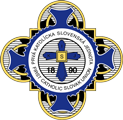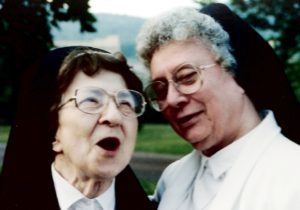It is no secret that immigrants have provided our nation with a strong and blessed support. Our Sisters who emigrated from central Europe have contributed mightily not only by their spiritual presence but also by the works they have performed in convents, parishes, schools, hospitals, homes for the elderly and by their very presence which has brought joy and comfort to all with whom they came into contact. If my calculations are correct, fifty-one Sisters have come to the U. S. to live fruitful lives and to minister to people who always proved to be thankful for their presence. I would like to introduce you to several of these Sisters who made a contribution to the health and well-being of their companions on the journey, especially those whom we called “house Sisters.” Some of them, of course, became teachers in the parish schools and sacristans in parishes and large institutions.
The next Sister I would like to introduce is Sister M. Claudia who was born in Slovakia, emigrated to the United States when she was 17, and entered the Sisters of Saints Cyril and Methodius in 1925.
Her Story: Sister M. Claudia

Sister M. Claudia was born Helen Šipka on December 13, 1903, in Dolná Streda, Slovakia, the oldest in a family of ten children, three boys and seven girls. After immigrating to New York City at age 17, she was welcomed by the Surmik family, who considered her a special gift of God. She became the godmother of the oldest child, Helen. All the children and grandchildren enjoyed her childlike enthusiasm for nature, birds, flowers and the ocean. They enjoyed the kolačky she baked and, like typical children, were delighted with the medals and holy cards she gave them. While in New York she was a parishioner of St. John Nepomucene Church and became a member of the Third Order of St. Francis. Agneška Hobrajter was the superior and when she learned that Helen wanted a more formal consecration of her life she advised her to go to Danville, “where the Slovak Sisters are.”
On July 6, 1925, Helen Šipka entered the Sisters of Saints Cyril and Methodius. She became a “house Sister,” and according to the tribute read at her funeral, “a cook with a character and charm all her own.” She was willing to share her wisdom, recipes, handy shortcuts, new ways of doing things. When she prepared a meal, she exerted time and energy to make it just right. She received many compliments for the food she produced, especially halušky. Her usual reply to compliments was, “You don’t say!” “Is it good? Is it?” Then, “I’m amazed.”
At a time when Sisters wore the full habit it was necessary to wear the guimpe even when working in the kitchen. Sister Brigid tells us that Sister Claudia minded wearing it when preparing meals because it made one hot because of the material it was made of. [Editor’s note: the guimpe was made of a stiff material such as starched linen, designed to cover the neck and shoulders and sometimes the entire chest and worn in combination with a coif and wimple in the traditional hablt.]
Her expertise extended to the task of cleaning the kitchen. She had good ideas for making jobs easier. Since she was small, she had to devise a way to clean the back of the large stove in the Motherhouse. Sister Brigid tells us that she used a broom wrapped in a cloth to attack the grime that may have lodged there.
Though limited in formal schooling her acquired English vocabulary was extraordinary. If you did not know she was an immigrant, you would have thought she had had a stellar education in American schools. Though limited in formal schooling, she was able to read aloud to her relatives who supplied her with books about the lives of the saints and the persecution of the early Christians. We can imagine it was just such reading that inspired her to later pursue a religious vocation.
From 1956-59, Sister Claudia was missioned to the novitiate to prepare meals for the novices. Of course, the novices were assigned to the kitchen to help in whatever way Sister needed. One day she asked Sister Celine (now Sister Mary Anne Nemec) to get her some tutti frutti. Sister registered surprise at the request wondering what tutti frutti might be. Sister Claudia was also surprised that this request for an ordinary food was puzzling. Sister Claudia exclaimed in wonder, “You don’t know what tutti frutti is? It turns out she wanted Sister to get the cans of fruit cocktail for dessert.
Sister Claudia always used the word “wutsies” when referring to the pigs we had on the farm at that time. She often declared, “You can put that in the garbage for the wutsies.” I have not been able to discover the origin of the word. No one seems to know, but everyone who worked with her was familiar with her word for “pigs.”
The doctors and nurses who attended her at the end of her life were impressed by her gentle smile and serene acceptance of her illness. They were even more touched when she said sweetly, “I am sincerely indebted to you.”
Her peaceful, kind approach to life were a result of her many hours of fervent prayer. She never tired of speaking of the pilgrimages to various Slovak Marian shrines she had experienced. Sister Claudia and the other Sisters who had come to the U. S. from Slovakia prayed, first of all, for perseverance, and also an increase of vocations to the congregation and unity in the Church. Since every religious community seems to be suffering from a dearth of applicants, it might be a good idea to call upon them for their intercession for vocations.
The Sisters who came to the US in their teens were always very happy to return for a visit. Sister Claudia received the opportunity to go to Slovakia for a family visit and the celebration of her Golden Jubilee. Her sister Anna was the housekeeper for Archbishop Jan Sokol. Sister was able to visit with him again when the Archbishop came to the U.S.
Sister Claudia was 88 years old when she died on October 10, 1992, Mary’s day, a Saturday. Her burial took place on the 75th anniversary of the miracle at Fatima. It is evident that our Lady to whom she was so dedicated watched over her until her last moments on earth. We look forward to meeting her in heaven along with our founder, Father Matthew Jankola, who described those who came to the U. S. from Slovakia as “transplanted linden trees.”
From the Editor: About the Linden Tree
As this excerpt from the 2018 book by Slovak scholars Dr. Zuzana Palovic and Dr. Gabriela Bereghazyova, SLOVAKIA: A JOURNEY INTO FREEDOM MARKED BY THE LINDEN TRADITION notes, the Linden – or in Slovak Lipa – has always been important to the Slovak people:
The Linden tree is the national tree of Slovakia and the sacred tree of the Slavs. The heart shaped Linden leaf reflects not only the location of Slovakia in the heart of Europe, its ancient roots and magnificent future, but also the heartfelt nature of her people. Slovaks truly are a people of generous heart, which is why they have chosen the Lipa insignia to represent them at every step of modern Slovak life.



